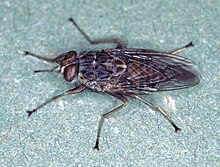
Back Tsetsevlieg Afrikaans ذبابة تسي تسي Arabic ذبابه تسى تسى ARZ Glossina AST Qlossina milçəkləri Azerbaijani قلوسینا میلچکلری AZB Мухи цеце Bulgarian Mosca tse-tse Catalan Tsetse CEB Moucha tse-tse Czech
| Tsetse fly | |
|---|---|

| |
| Glossina morsitans | |
| Scientific classification | |
| Domain: | Eukaryota |
| Kingdom: | Animalia |
| Phylum: | Arthropoda |
| Class: | Insecta |
| Order: | Diptera |
| (unranked): | Eremoneura |
| (unranked): | Cyclorrhapha |
| Section: | Schizophora |
| Subsection: | Calyptratae |
| Superfamily: | Hippoboscoidea |
| Family: | Glossinidae Theobald, 1903 |
| Genus: | Glossina Wiedemann, 1830 |
| Species groups | |
| |

| |
| Range of the tsetse fly | |
Tsetse (/ˈsiːtsi/ SEET-see, US: /ˈtsiːtsi/ TSEET-see or UK: /ˈtsɛtsə/ TSET-sə) (sometimes spelled tzetze; also known as tik-tik flies) are large, biting flies that inhabit much of tropical Africa.[1][2][3] Tsetse flies include all the species in the genus Glossina, which are placed in their own family, Glossinidae. The tsetse is an obligate parasite, which lives by feeding on the blood of vertebrate animals. Tsetse has been extensively studied because of their role in transmitting disease. They have pronounced economic and public health impacts in sub-Saharan Africa as the biological vectors of trypanosomes, causing human and animal trypanosomiasis.[4][5]
Tsetse can be distinguished from other large flies by two easily-observed features: Primarily, tsetse fold their wings over their abdomens completely when they are resting (so that one wing rests directly on top of the other); Secondly, tsetse also have a long proboscis, extending directly forward, which is attached by a distinct bulb to the bottom of their heads.
Fossilized tsetse has been recovered from Paleogene-aged rocks in the United States and Germany. Twenty-three extant species of tsetse flies are known from the African continent as well as the Arabian Peninsula.
- ^ Ford, J. (1963). "The distribution of the vectors of African pathogenic trypanosomes" (PDF). Bulletin of the World Health Organization, 28(5–6): 653–669. 28 (5–6): 653–669. PMC 2554952. PMID 13958704.
- ^ Rogers, D. J.; Robinson, T. P. (January 2004), Maudlin, I.; Holmes, P. H.; Miles, M. A. (eds.), "Tsetse distribution.", The trypanosomiases (1 ed.), UK: CABI Publishing, pp. 139–179, doi:10.1079/9780851994758.0139, ISBN 978-0-85199-475-8, retrieved 28 October 2024
- ^ Cecchi, G.; Paone, M.; de Gier, J.; Zhao, W. (2024). The continental atlas of the distribution of tsetse flies in Africa. FAO. doi:10.4060/cd2022en. ISBN 978-92-5-139040-5.
- ^ Swallow, B. M. (2000). Impacts of Trypanosomiasis on African agriculture. PAAT Technical and Scientific Series, No. 2. Rome: FAO. ISBN 978-92-5-104413-1.
- ^ Büscher, Philippe; Cecchi, Giuliano; Jamonneau, Vincent; Priotto, Gerardo (November 2017). "Human African trypanosomiasis". The Lancet. 390 (10110): 2397–2409. doi:10.1016/S0140-6736(17)31510-6. PMID 28673422.